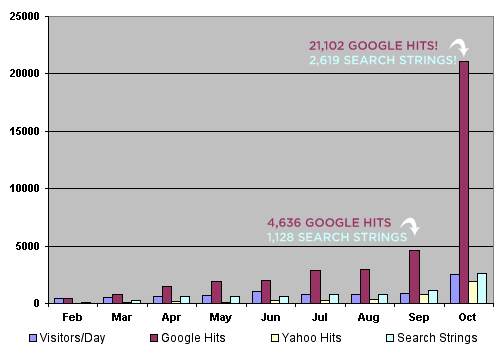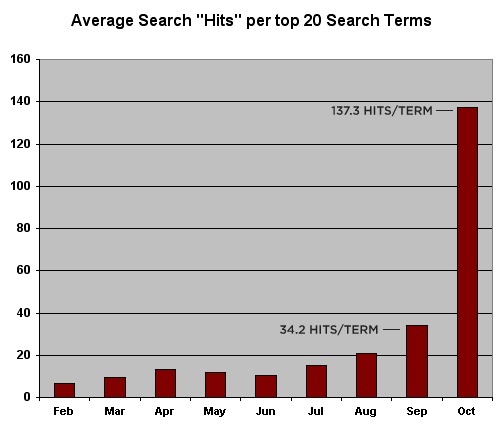In the beginning of October, I made two notable changes to this Web site that resulted in a massive increase in traffic from search engines.
Naturally, I’d love to share both the method and the results with you, so come with me on a 3 minute journey to SEO domination. Oh, and did I mention that it comes complete with graphs? You can’t lose!
Two Simple Changes, One Huge Result
In late September, I began to lose interest in this site because I felt as though MovableType, my old CMS platform, was badly lagging WordPress in the easy-to-use features department.
As I began to roll out this latest design, I realized that proper SEO was about a thousand times easier to implement with WordPress, so I finally gave in and ported the entire site over to what I think is the best CMS on the planet.
Turns out this was the best move ever.
On top of that, I based the architecture of this new design on the Cutline framework, which I built from scratch with SEO in mind. With the exception of auto-generated meta tags (whose importance is arguably depreciating), pretty much every aspect of Cutline is geared towards producing effective SERPs.
So, to review, I made two notable changes to this Web site in early October:
- I ported my blog from MovableType to WordPress.
- I based the new design’s code on the Cutline framework.
…and the results have been nothing short of amazing.
Data, graphs, and all the proof your little heart desires
The last time I spoke about SEO, I attributed my recent traffic surge to this site’s emergence from the Google sandbox. Now that I’ve had a chance to further analyze my data from October, though, I think that I may have been at least partially incorrect in my views on the sandbox.
Getting out of the sandbox represents opportunity, but it guarantees you nothing. You can take advantage of this opportunity by setting your site up the right way, and that’s the entire reason for the existence of this post.

Figure 1. Monthly hits from Google (and Yahoo!) and also the total number of search strings that were used to access the content on this site.
In the image above, note how my search engine traffic jumped an astounding 455% from September to October. On top of that, the total number of search strings that resulted in visits to my site jumped up 232%, from 1,128 to 2,619.
Based on raw data from September (which is not shown for the sake of brevity), it’s clear that at least 90% of this site was indexed in Google during that month. Therefore, even if I were to conjecture that the remaining 10% were indexed in October, this certainly wouldn’t account for a 455% increase in search engine traffic.
Without question, there’s something else going on here. But what is it?
It’s definitely the two major changes that I implemented on October 3rd — the switch to WordPress coupled with the new Cutline architecture.
And it gets even better, because there’s more detailed information to be had from the data in Figure 1. To illustrate this further, let’s take a look at the most compelling facts.
First, I already mentioned that my search strings rose from 1,128 to 2,619. Your server will register a search string whenever someone searches for something and ends up on your site via a link in the SERPs. Obviously, the higher you rank for different topics, the more strings you’re likely to register over the course of a month.
Second, because I had so many more search strings than before, it should come as no surprise that I also showed an associated increase in the overall number of hits from search engines. Based on the increase in search strings, I think it would have been safe to conjecture that I would see an increase in SE hits in the neighborhood of 232%. The real results, however, were nearly twice this good, coming in at an astounding 455%.
So, based on the increases I saw from September to October, I think it’s reasonable to draw the following conclusions:
- The content on this site was far more accessible (232% more accessible) in October than it was in previous months (to put it another way, all my indexed content was more search engine friendly)
- The pages of my site were ranking higher in the SERPs for the strings in question
The information contained in the following graph suggests that at least a few of my pages were, in fact, ranking higher than they had in previous months.

Figure 2. Monthly average of the number of hits on each of my top 20 search terms.
In my last post on the Google sandbox, I made the claim that the data in Figure 2 (shown above) is basically equivalent to the amount of trust Google has placed in your site on those particular search terms. The higher you rank, the higher your trust. Therefore, the higher the average in Figure 2, the higher you rank for your top 20 terms (on average).
I still think this is true, but it’s always nice to have visual evidence that backs up claims of “if you do this, then your search engine rankings will improve this much.”
The Bottom Line
Converting your site to an easy-to-manage CMS platform like WordPress and then placing it on a proven foundation like Cutline (update: you need Thesis now) are quite possibly the highest-impact changes you could make.
There are countless commercial implications from a simple analysis like this, and if you’ve been wondering what your next step on the Web ought to be, I certainly recommend you try this before doing anything else.